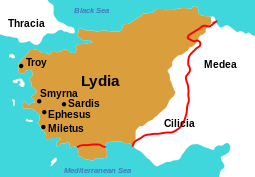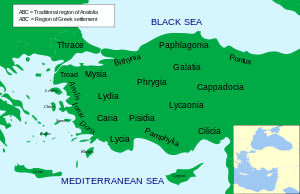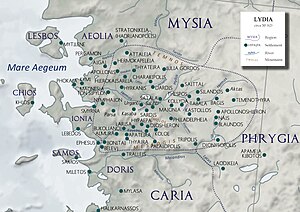Lydian empire
| Lydia (Λυδία) | |
|---|---|
| Ancient Region of Anatolia | |

Map of the Lydian Empire in its final period of sovereignty under Croesus (red lines = 7th century BC extent)
|
|
| Location | Western Anatolia, Salihli, Manisa, Turkey |
| State existed | 1200–546 BC |
| Language | Lydian |
| Historical capitals | Sardis |
| Notable rulers | Gyges, Croesus |
| Persian satrapy | Lydia |
| Roman province | Asia, Lydia |
 |
|
 |
|
Lydia (Assyrian: Luddu; Greek: Λυδία, Turkish: Lidya) was an Iron Age kingdom of western Asia Minor located generally east of ancient Ionia in the modern western Turkish provinces of Uşak, Manisa and inland İzmir. Its population spoke an Anatolian language known as Lydian.
At its greatest extent, the Kingdom of Lydia covered all of western Anatolia. Lydia (Sparda in Old Persian) was a satrapy of the Achaemenid Persian Empire, with Sardis as its capital.Tabalus, appointed by Cyrus the Great, was the first satrap.
Lydia was later the name of a Roman province. Coins are said to have been invented in Lydia around the 7th century BCE.
The endonym Śfard (the name the Lydians called themselves) survives in bilingual and trilingual stone-carved notices of the Achaemenid Empire: the satrapy of Sparda (Old Persian), Aramaic Saparda, Babylonian Sapardu, Elamitic Išbarda, Hebrew סְפָרַד. These in the Greek tradition are associated with Sardis, the capital city of King Gyges, constructed during the 7th century BCE.
...
Wikipedia
